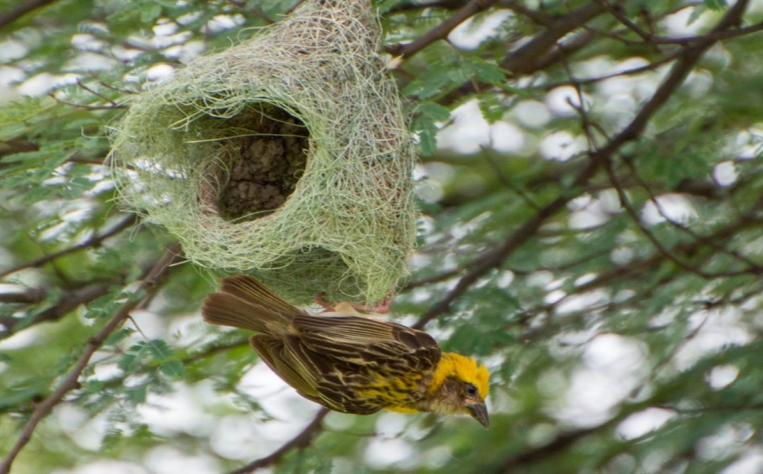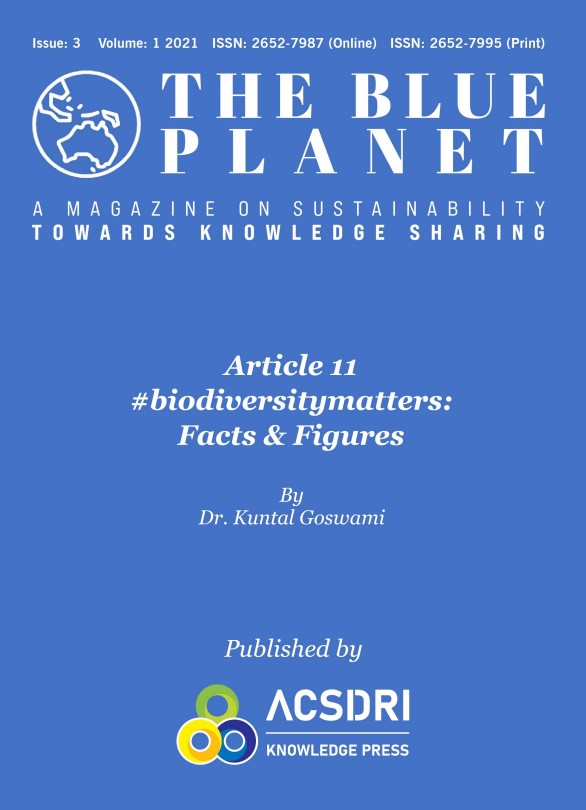#biodiversitymatters:
Facts & Figures
Biodiversity matters : Facts and Figures
By Dr. Kuntal Goswami, Founder of ACSDRI
Key words: Biodiversity matters: Facts & Figures; Causes of Biodiversity Loss; Biodiversity; Wildlife Crime; Sustainable Development Goals; SDG-15; Life on Land; SDG-14; Life below water; threat to marine life; marine habitat; natural habitat; biodiversity facts and figures.
Citation: Goswami, K (2021), ‘#biodiversitymatters: Facts & Figures on Biodiversity’, The Blue Planet – A Magazine on Sustainability, Australian Centre of Sustainable Development Research & Innovation (ACSDRI), Australia and South Asian Institute of Sustainable Development (SAISD), Issue 3 Vol-1, pp. 64-89. ISSN: 2652-7987 https://acsdri.com/biodiversity-knowledge-forum/biodiversity-matters/
Loss of Biodiversity: A Global Crisis
Throughout the world biodiversity is declining at an alarming rate. We intend to make an emotional appeal to save biodiversity through bio-diversity related facts and figures and nature photography. The SDGs 14 & 15 are related to conserve & protect biodiversity.
Creeping development activities leading to significant amounts of forest loss. Between 2000 to 2020, globally the proportion of forest area declined from 31.9 percent to 31.2 percent. This marginal decline equates to 100 million hectares of forest area. The primary reason for this loss is due to expansion of agriculture. At the same time, the Food Waste Index Report 2021 highlights that around one-third of food produced globally gets lost or wasted (i.e. 1.3 billion tones each year). SO, DO WE REALLY NEED MORE AGRICULTURAL LAND?
Throughout the world, Biodiversity is declining at an alarming rate. The Australian Centre for Sustainable Development Research and Innovation (ACSDRI) emotionally appeals to save Biodiversity through this educational info-photographic blog. The United Nations has designed two dedicated goals to conserve and protect Biodiversity:
● SDG 15 focuses on “Life on Land”: to protect, restore, and promote sustainable use of terrestrial ecosystems; to sustainably manage forests, combat desertification; to halt and reverse land degradation; and finally, to halt biodiversity loss.
● SDG 14 focuses on the “Life below water,” intending to conserve and sustainably use our oceans, seas, and marine resources for Sustainable Development.
Aligning with the UN’s global goals, SDG-14 and SDG-15, to protect Biodiversity, the ACSDRI has designed the #biodiversitymatters campaign to educate and make the global communities aware of biodiversity loss.
Sustainable Development depends on the quality of natural resources and Biodiversity to meet social and economic developmental needs. However, only 7.8 % of SDG targets directly quantify natural resources. 8.2% of SDG targets measure the conditions for natural resource protection. 84% of SDG targets measure socio-economic Development. In addition, a recent trend suggests that only one-third of countries are on track to achieve their national biodiversity targets.
#biodiversitymatters: Facts & Figures
Photography By
Alankar Chandra
Photography by
Dr. Veena Sagar

Photography by
Sivarajan

Rate of Biodiversity Loss
Up to 1970, our ecological footprint was smaller than the Earth’s regeneration rate. Between 1970 and 2016, there has been a sharp decline in a wide range of species. In 2020 we are overusing the Earth’s biocapacity by at least 56%. Because of the creeping development activities of Homo sapiens, the planet Earth is facing significant amounts of forest loss within such a short geological period.
Between 2000 and 2020, globally, the proportion of forest area declined from 31.9 percent to 31.2 percent. This marginal decline equates to 100 million hectares of forest area. The primary reason for this loss is due to expansion of agriculture. At the same time, the Food Waste Index Report 2021 highlights that around one-third of food produced globally gets lost or wasted (i.e., 1.3 billion tonnes each year).
In creating more agricultural lands, we also destroy many natural biodiversity hotspots. SO, DO WE NEED MORE AGRICULTURAL LANDS?
Photography By
Ketan Talati
Photography By
Prashant Pawar
Photography By
Mohamed Mazher Y
Photography By
Alankar Chandra
Causes of Biodiversity Loss
In the following section, we have highlighted the roles of different species in nature, including insects, butterflies, elephants, bees, and birds. It is estimated that, on average, there is a 68% decrease in the population sizes of mammals, birds, amphibians, reptiles, and fish.
The main reasons are that over the last 50 years, there have been significant increases in human populations, consumption, urbanization, and habitat loss. The rate of decline is different across the region. However, tropical areas saw the most significant decline in Biodiversity. Between 2000 and 2020, forest area increased in Asia, Europe, and North America. However, significant decreases have been noticed in Latin America, Sub-Saharan Africa, and Southeastern Asia.
In the section, we have also briefly showcased how human intervention and rising wildlife crime lead to biodiversity loss and endangering many species in nature. The data shows biodiversity loss and wildlife crime are not limited to land; the extent of biodiversity destruction due to human intervention and unchecked economic activities is happening much more in the marine habitat.
Insects: Are they enemies? or are they the essential POLLINATORS?
The insect population accounts for about two-thirds of all terrestrial species. However, a 27-year longitudinal study shows that in several of Germany’s protected areas, about 76% of its flying insect biomass has been lost. At the same time, the silver lining is that the insect population can be recovered quickly with little support.
Photography By
Roshan Lal
Photography By
Mohamed Mazher Y
Photography By
Subramanya Muralidhara
Photography By
Mohamed Mazher Y
Elephants – Ecosystem Engineers
About 20,000 African elephants are estimated to be killed yearly for their tusks, and only 400,000 African elephants are left in the wild from a population of 12 million a century ago. Commercially, ivories are sold in the United States, China, Thailand, and Hong Kong. Elephants are the ecosystem engineers. They help to maintain the savanna, disperse seeds, and create pathways in the dense forest for other animals.
- Wholesale prices for illegal ivory in China over the years were US$ 750 per Kg in 2010, US$ 2100 per Kg in 2014, US$ 1100 per Kg in 2015, and US$ 728 in 2018.
- Ivory prices paid to poachers in Kenya and Tanzania were between US$148 to 95 per kg in 2014, US$ 88 to 78 per Kg in 2016, and US$ 54.5 to 40 per kg in 2018.
Photography By
Alankar Chandra
Bees – Essential Pollinators
Bees are the most essential pollinators: over 16,000 known bee species worldwide. Bees pollinate about 70 of the 100 crop species. About 90 % of the world’s population depends on bees. Hence bees are essential to human life. It is estimated that honeybee pollination contributes four to $AUS six billion to the Australian economy. Unfortunately, globally, the bee population is declining at an alarming rate.
Between 2006 and 2016, Australia lost 100 thousand commercial honeybee hives, and among the Australian states and territories, New South Wales, Victoria, and Queensland lost the most. Exposure to pathogens, agrochemicals, and habitat loss and degradation are the main causes of decline in the bee population.
Dr Kuntal Goswami
Photography By
Photography By
Chidambar Javoor
Growing Bird population equates to improving the biodiversity of the region.
Photography By
Prateek Agarwal
Photography By
Bhaskar Nandi
Photography By
Deviprasad Rao
International Wildlife Crime: Facts & Figures
Wildlife crime endangers animal species and increases the chances of spreading unknown and deadly diseases. The data shows that seventy-five percent of emerging infectious diseases, such as Bird flu, Ebola, and COVID-19, are zoonotic.
Habitat encroachment and land degradation are primary pathways for new infectious disease transmission. Globally, one-fifth of the Earth’s land area (equivalent to the combined land mass of Russia and India) is degraded, and land degradation is affecting the well-being of 3.2 billion people.
What is wildlife crime?
Wild Life crime is defined as harvesting and trading contrary to national law. Between $48 to $153 billion of resources are lost due to the illegal Wildlife Trade.
Photography By
Anuj Mukherjee
Trade of Rhinos Horne – The Greatest Wildlife Crime
Today, only about 27,000 rhinos remain in the wild, whereas in 1973, this figure was 70,000. Nowadays, very few rhinos can survive outside national parks and reserves because of poaching and habitat loss.
The average wholesale price of whole rhino horn is about US $ 18,881 per Kg. The average wholesale price of whole rhino horn is about US $ 18,881 per Kg.
Photography By
Anuj Mukherjee
Trade of Animal Bone – A Wildlife Crime
Photography By
Alankar Chandra
Photography By
Alankar Chandra
Illegal Trade of Big Cats – A Wildlife Crime
Illegal trade and Habitat loss are the biggest threats to Cheetahs. About 6,674 of the adult Cheetah population is left in the wild. The Maasai Mara ecosystem is home to approximately 25% of Kenya’s wildlife. It hosts over 95 mammal species and is a recognized Important Bird Area (IBA) with 550 bird species.
- In the United States, no federal law prohibits possessing and selling big cats and exotic pets, including tigers and lions.
- In the US, privately owned commercial facilities crossbreed big cats, with some generating over US $ 1 million per year.
Photography By
Anuj Mukherjee
Photography By
Anuj Mukherjee
Cheetah - the endangered BIG Cat
Photography By
Anuj Mukherjee
Photography By
Alankar Chandra
Different Actors of the Wildlife Crime Network:
- Coordinator: controls or organizes a trafficking network.
- Courier: physically sends parcels or transports animals.
- Domestic Trader: deals in the domestic trade of animals.
- Transporter: transports animals domestically for a fee.
- Money mule: receives funds on behalf of the coordinator.
- Overseas trader: illegal exporter.
- Poacher: hunts and traps live animals on behalf of the coordinator.
Photography By
Alankar Chandra
Cause of marine life destruction: Facts and Figure
What is Bycatch?
Bycatches are unintentional or incidental capture of non-targeted species. More destruction of marine life happens every day due to Bycatch.
Significant effect of Bycatch on the ocean environment
- Dolphins, marine turtles, seals, seabirds, sharks, juvenile fish, fish with little commercial value, corals … billions of unwanted animals are caught annually by fishing boats then discarded dead into the ocean
- Bycatch is a waste. Many millions of tonnes of marine life get wasted every year as Bycatch.
Photography By
Ratnadeep Khan

